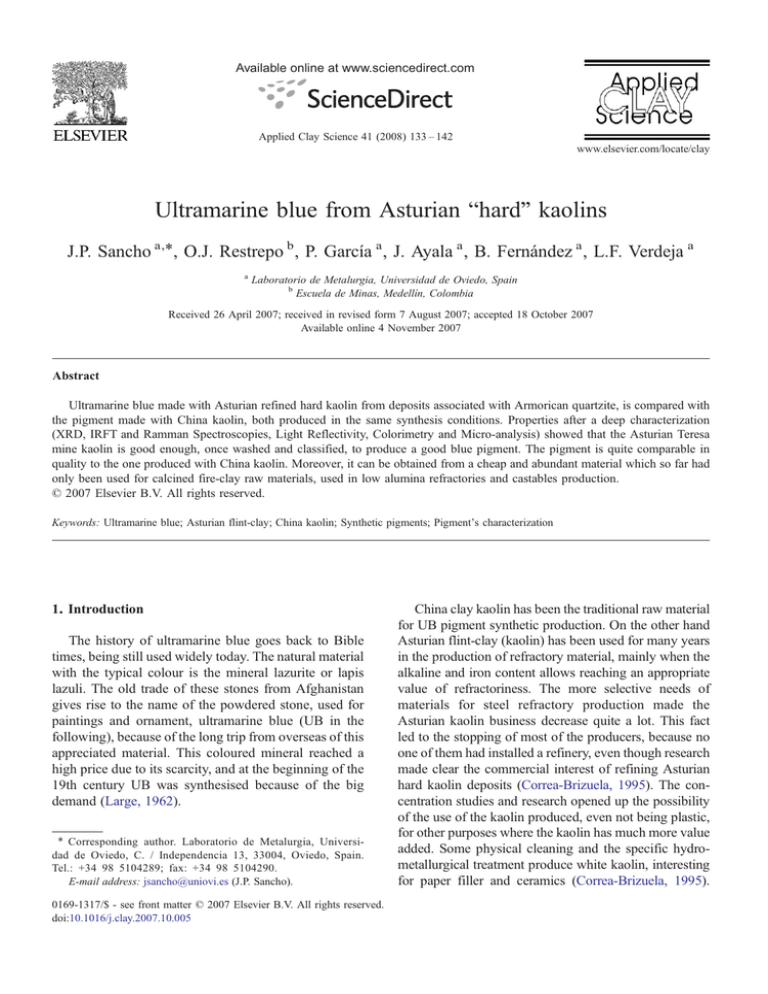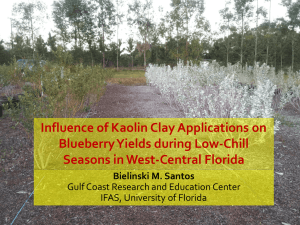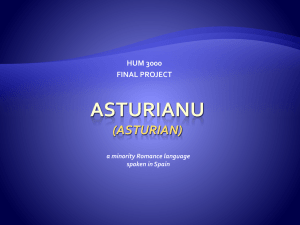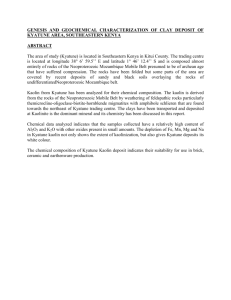
Available online at www.sciencedirect.com
Applied Clay Science 41 (2008) 133 – 142
www.elsevier.com/locate/clay
Ultramarine blue from Asturian “hard” kaolins
J.P. Sancho a,⁎, O.J. Restrepo b , P. García a , J. Ayala a , B. Fernández a , L.F. Verdeja a
a
Laboratorio de Metalurgia, Universidad de Oviedo, Spain
b
Escuela de Minas, Medellín, Colombia
Received 26 April 2007; received in revised form 7 August 2007; accepted 18 October 2007
Available online 4 November 2007
Abstract
Ultramarine blue made with Asturian refined hard kaolin from deposits associated with Armorican quartzite, is compared with
the pigment made with China kaolin, both produced in the same synthesis conditions. Properties after a deep characterization
(XRD, IRFT and Ramman Spectroscopies, Light Reflectivity, Colorimetry and Micro-analysis) showed that the Asturian Teresa
mine kaolin is good enough, once washed and classified, to produce a good blue pigment. The pigment is quite comparable in
quality to the one produced with China kaolin. Moreover, it can be obtained from a cheap and abundant material which so far had
only been used for calcined fire-clay raw materials, used in low alumina refractories and castables production.
© 2007 Elsevier B.V. All rights reserved.
Keywords: Ultramarine blue; Asturian flint-clay; China kaolin; Synthetic pigments; Pigment's characterization
1. Introduction
The history of ultramarine blue goes back to Bible
times, being still used widely today. The natural material
with the typical colour is the mineral lazurite or lapis
lazuli. The old trade of these stones from Afghanistan
gives rise to the name of the powdered stone, used for
paintings and ornament, ultramarine blue (UB in the
following), because of the long trip from overseas of this
appreciated material. This coloured mineral reached a
high price due to its scarcity, and at the beginning of the
19th century UB was synthesised because of the big
demand (Large, 1962).
⁎ Corresponding author. Laboratorio de Metalurgia, Universidad de Oviedo, C. / Independencia 13, 33004, Oviedo, Spain.
Tel.: +34 98 5104289; fax: +34 98 5104290.
E-mail address: jsancho@uniovi.es (J.P. Sancho).
0169-1317/$ - see front matter © 2007 Elsevier B.V. All rights reserved.
doi:10.1016/j.clay.2007.10.005
China clay kaolin has been the traditional raw material
for UB pigment synthetic production. On the other hand
Asturian flint-clay (kaolin) has been used for many years
in the production of refractory material, mainly when the
alkaline and iron content allows reaching an appropriate
value of refractoriness. The more selective needs of
materials for steel refractory production made the
Asturian kaolin business decrease quite a lot. This fact
led to the stopping of most of the producers, because no
one of them had installed a refinery, even though research
made clear the commercial interest of refining Asturian
hard kaolin deposits (Correa-Brizuela, 1995). The concentration studies and research opened up the possibility
of the use of the kaolin produced, even not being plastic,
for other purposes where the kaolin has much more value
added. Some physical cleaning and the specific hydrometallurgical treatment produce white kaolin, interesting
for paper filler and ceramics (Correa-Brizuela, 1995).
134
J.P. Sancho et al. / Applied Clay Science 41 (2008) 133–142
Table 1
Chemical composition of kaolins, wt.%
Asturian
China
SiO2
Al2O3
Fe2O3
TiO2
CaO
MgO
K2O
Na2O
L. on I.
49
48.5
37
38
0.35
1.1
0.9
0.03
0.10
0.10
0.03
0.30
0.50
1.85
0.10
0.10
12.02
10.02
This paper deals with the use of Asturian kaolin for UB
pigment synthesis in comparison with China clay kaolin
from Devon.
Industrial procedure for UB fabrication was developed by J.B Guimet in Toulouse (France) and C. Gmelin
in Germany 1828. F.A. Köttig improved the process for
the Royal Porcelain Manufacturing (Mertens, 2004).
Different UB formulations can be found in the
bibliography (Prener and Ward, 1950; Hofmann and
Herzenstiel, 1964; Hofmann et al., 1969; Schawarz and
Hofmann, 1970; Tarling et al., 1988; Gordillo et al.,
1992; Cork, 1993; Gobeltz-Hautecoeur et al., 2002)
and Corck (1993) gave the following range composition: Na 6.3–10, Al 4.8–6, Si 6–7.2, O 24, S 1–4.5.
Structurally UB pigment has an aluminosilicate framework (sodalite type) with Na+, S2−, S3− and SO4= ions
inside (Chivers and Drummond, 1973; Tarling and
Barnes, 1988; Gobeltz et al., 1998; Reinen and Lindner,
1999; Arieli et al., 2004). S3− polisulphur radical
produces the strong blue colour as could be deduced
Fig. 1. XRD pattern of China and Asturian kaolins: I: Illite, K: kaolinite, P: pyrite, Q: quartz, A: anatase, G: graphite.
J.P. Sancho et al. / Applied Clay Science 41 (2008) 133–142
Table 2
Activation temperature determination by colour results
Sample
T (°C)
Light
L
a
b
China
Asturian
700
750
700
680
650
N (natural)
N
N
N
N
34.5
37.5
38.5
35.5
37.5
18.5
15.0
14.0
18.5
17.3
− 51.2
− 48.5
− 47.2
− 50.5
− 50.1
from most references that attribute to S3− chromophore
the blue colour of the UB (Wieckowski, 1970; Chivers
and Drummond, 1973; Tarling and Barnes, 1988;
Gobeltz-Hautecoeur et al., 2002). For that, characterization of UB is done frequently determining the presence of
this polyanion and quantifying it.
The structure and nature of UB has been studied by
different methods: XRD, NMR, RE, IRS, ESR, EPR
(Clark and Cobbold, 1978; Bell et al., 1997; Landman
and de Wall, 2004; Arieli et al., 2004). Colour
characterization is made by the determination of the
colorimetric parameters and making visible reflectance
studies (Gobeltz et al., 1998; Kowalisky, 1990).
Some of the best representations of the UB crystal
structure are described in the papers by Tarling and Barnes
(1988) and Gobelts-Hautecoeur et al. (2002), that include
the S3− chromophore and four Na+ cations. This shows
only three Na+ cations and the S3− chromophore polyion.
A β-cage containing the ions, as well as the geometrics of
S3−, S2− and (Na4S3)3+, with the interatomic distances,
are described by Arieli et al. (2004). Not all the β-cages
are filled with S3−, being possible the filled percentage
determination.
Colorimetric studies of the pigment follows the
indications defined by the Commission International
d'Eclarage CIE (1976) as described in the works of
Gobeltz and Kowalisky (Kowalisky, 1990; Gobeltz
et al., 1998; Gobeltz-Hautecoeur et al., 2002).
135
supplier. The Asturian kaolin from Teresa mine in Tineo, was
crushed and trommelled for disintegration. Fine material, less
than 100 μm, was classified and concentrated by cycloning,
producing silica and sulphide separation, and obtaining a fine
product less than 45 μm size. Usually, graphite and iron
minerals are eliminated by oxidation treatment using traditional sodium hypochlorite and sodium bisulphide oxidation,
producing the whiter product used in the paper industry, but in
our case material can be used directly after classification,
because neither carbon nor sulphides are deleterious, moreover
they are added for UB fabrication. Silica fines are also good for
the pigment production, as some extra silica is needed over the
compositional one from the clay.
The kaolins used were mineralogical and chemically
characterized, showing that they have similar chemical
composition (Table 1, Fig. 1). Table 1, shows the chemical
composition of two kaolins: the English commercial China
clay from Devon and the Asturian one. Theoretical Si/Al ratio
in pure kaolin is 1.04; in practice China one used had 1.13 and
the Asturian 1.17. Asturian kaolin has a bit less alumina and
more silica and titanium oxide than China one, but has less
potassium, iron and magnesium. Asturian kaolin, from Teresa
mine is quite pure, with some signals of quartz, rutile/anatase
and very small of pyrite illite and graphite. China kaolin has as
minoritary minerals illite and orthoclase.
Quartz material was ground (b45 μm) sands, from Arija
(Burgos) sand deposits used for glass making, having more
than 98% SiO2.
Metallurgical pitch, the quality used for aluminium
electrodes, from IQN was used as reducer material.
2. Experimentation
2.1. Raw materials preparation and characterization
The China clay kaolin was a commercial one from Dovey
Basin, Devon England and was used as received from the
Table 3
Asturian and China ultramarine blue composition, wt.% (EDAX
plus AA)
UB
Element
O
Na
Al
Si
S
K
Fe
Ti
Asturian
China
47.0
45.9
12.5
12.2
11.9
11.8
18.2
17.6
9.4
10.7
0.58
0.66
0.41
1.24
0.3
0.05
Fig. 2. Thermal analysis of the synthetic process of China and Asturian
ultramarine blues.
136
J.P. Sancho et al. / Applied Clay Science 41 (2008) 133–142
Sodium carbonate was the Na supplier and pure sulphur as
the chromophore generator, both industrial qualities from
Probus P.Q.
2.2. Procedure of fabrication
The fabrication procedure was the same for both materials,
except for the activation temperature that was 700 °C for China
clay, value taken from bibliography (Landman and de Wall,
2004) and 680 °C for Asturian one as a result from some
tentative colour quality determinations, (see Table 2).
Once the kaolin was calcined, mixtures were prepared
following some practical experience of the authors and the
indications from some references in the literature (Landman
and de Wall, 2004), as follows: Calcined kaolin 35–37%,
sodium carbonate 29–33%, sulphur 28%, ground quartz 5–
10% and ground pitch 5–6%. Some additional silica, as quartz,
was used to reach the required silica–alumina relationship for
a good final product.
The mixture of the components was done in a rotary mixer,
till full homogeneity. The mixture was charged in flat 50 cm3
ceramic container, introduced in a tube furnace and kept for 10–
12 h at 750 °C. Afterwards, the sample was oxidized in the same
furnace, by opening the ends at 550–600 °C for 3 h, having the
precaution of not over oxidizing the material, using ceramic hole
ends. In all the experiments, the 3–5 mm upper layer was
discarded, grinding the rest in a ring mill till uniform colour (less
than 45 μm). The powder was washed with water for sodium
sulphate removal, and then dried at 110 °C for characterization.
3. Product characterization
Products were characterized by Atomic Absorption
spectrometry (AAS) and Energy Dispersive Spectroscopy (EDS), colorimetric, IRFT and Raman spectroscopies, X-ray diffraction (XRD) and Thermal Analysis
(DTA–TG).
Fig. 3. XRD pattern of China and Asturian U.B (L: Lazurite, P: Pyrite).
J.P. Sancho et al. / Applied Clay Science 41 (2008) 133–142
Chemical composition analysis of UB materials was
done in a Jeol JSM-6100 equipped with EDAX
(averaging in 20 points in the powder sample) and by
AAS using a Pye Unicam SP 9 equipment.
Thermal analysis was made using a Chio Balance
model TRDA3-H, being the experimental conditions:
Heating rate: 10 °C/min., DTA: 100 μV, air atmosphere,
sample 100 mg, crucible of platinum.
Infrared spectra have been obtained with a
Fourrier Tranformed I R 560 from Nicolet, through
137
a KBr source globar and DTGS piezoelectric
detector. Spectra were obtained at 4 cm− 1 resolution, under vacuum, 64 pellet scans between 4000
and 400 cm− 1 . 13 cm diameter and 120 mg pellet
was prepared, using KBr matrix in a 1/100 sample/
matrix relationship.
An H R 800 Jovin Yvon Horiba was used for
Ramman spectroscopy, taking the green line of an argon
laser (λ = 514, 5 mm) as calibrating source, equipped
with CCD camera. Power was 25 mW, excitation time
Fig. 4. Infrared spectra: Asturian Blue
China Blue
.
138
J.P. Sancho et al. / Applied Clay Science 41 (2008) 133–142
30 s, doing two spectra. Laser focalization was done on
the powder sample with an Olympus M Plan optical
microscope under 100× objective. Spectra were
obtained between 200 and 1400 cm− 1.
XRD patterns were obtained in a PW 3040/60 Philips
diffractometer, with Cukα cathode, graphite monochromator, 0.04 and 0.3 slits, 40 kV, 40 A, 0.02 2θ/s, running
5–80°.
LENETA FORM 24-H-OPACITY cardboard was
used for colour preparation. 10% pigment was
homogeneously suspended in a polyurethane transparent resin, and then was extended with an Elcometer
film 3520 Baker applicator on the form as a 250 μm
layer. Datacolor Spectraflash SF 450 spectrophotometer was used for colorimetric and reflectance
studies. L⁎, a⁎, b⁎, C⁎ and h⁎ CIE parameters were
determined with natural day, wolfram yellow lamp and
fluorescent tube lights (D65, Y, F). Reflectance versus
wavelength, measured between 350 and 700 nm, was
obtained.
4. Results and discussion
Analytical elemental composition of the two synthesised blues is presented in Table 3. Some chemical
differences are observed between both materials, but
they will not have effect on the S3− modification or
stabilization (Booth et al., 2003), differentially affecting
therefore the reddish shade in both products.
The sulphur analysed is the chromophore source
internally inserted, because both UB products has been
very well water washed. There is a higher content in the
China clay blue, so there are some reasons for expecting
slightly better quality in this one, but iron content is higher
than the Asturian blue, which according to Landman and
de Wall (2004) can affect the quality of the product.
Asturian blue is more consistent after fabrication,
probably because of the clay fineness or sinterization
effects by compositional or structural reasons. The
grinding of this product increases the operation time, but
no changes have been observed on the product colour.
Fig. 5. Ramman spectra of China and Asturian U.B.
J.P. Sancho et al. / Applied Clay Science 41 (2008) 133–142
DTA and TG analysis show that the two blues are
similar (Fig. 2); in fact, only a higher stability of the
kaolin is appreciated at dehydroxilation temperatures in
the TGA and a slightly smaller exothermic is obtained
with the Asturian blue between 600 and 750 °C, zone of
blue synthesising, that could indicate some poorer or
more difficult reactivity.
139
XRD studies, (Fig. 3), show a very high similitude
between the Asturian and the China blues. The patterns
correspond to Lazurite. Some pyrite is also detected in
China blue.
Infrared spectra of the two pigments (Fig. 4) present
typical sodalite bands, and correspond in both cases to
ultramarine blue. Absorbance bands correspond to the
Table 4
Comparative Ramman signals of different samples spectra, including the Asturian and the China UB synthetized in this work, and its sulphur ions
correspondence
U Red Clark U Blue Clark U Blue (M.) U Blue f.a. LazuriteBellClark U Red
U Industrial U. China
U Asturian Assigned Sx−
216 w
255 w b
S3− bending
255 w b
256 w b
258 w
258 w b
S3− bending
259 w b
293 w sh
296 w sh
352 w b
410 w s
S4
?
461 w
545 st s
546 st s
546 st s
547 st s
S3− sim.stretch
S3− sim.stretch
548 st s
550 s
ν1 (S3−)
S2−
547 w
565 m sh
566 m sh
568 sh
570 m sh
580 w sh
580 w sh
586.5
S2−
ν (S2−)
ν (S2−)
626 w
653.5 w–m
674 m
675 w b
804 w b
806 w b
S4
ν1? S4
806
813 w b
813 w b
822 w
994 short
1024 w b
S4
2ν (S2−)
1186
1092 m b
1093 w b
1095 m b
2ν1 (S3−)
S3− overtone
1096 m b
1097 m b
S3− overtone
1097 m b
1099 m b
1340 w b
1345 w b
1358 w b
S4
S4
S4
1360 w b
1644 w b
1650 w b
1747
3ν1 (S3−)
3ν (S2−)
140
J.P. Sancho et al. / Applied Clay Science 41 (2008) 133–142
Fig. 6. Reflectance spectra of China and Asturian ultramarine blue.
chromophore S3−. Some researchers (Clark and Cobbold,
1978) found strong bands at 582 and 547 cm− 1 assigned
to ν3 and ν1 frequencies from the S3− ion. In Fig. 4 these
bands are found around 582–583 and 537 cm− 1 in both
samples, the China and the Asturian blues, with very
small differences. The ν1 band is also found in the same
wavenumber in the Ramman spectra 546–547 (Fig. 5)
and it can mean that the mentioned ion is a nonlineal one.
Regarding the peak intensity, in our case, ν3 peaks are
similar (582–583 cm− 1) in both blues, but ν1 is stronger
in the China blue, and is recorded at 538 cm− 1, similarly
to other synthetic blues (Landman and de Wall, 2004)
recorded at 542, not far from the referenced standard blue
(547 cm− 1).
Ramman spectra of produced China and Asturian
UB, (Fig. 5), are compared with different referenced and
standard blues in Table 4, where the lines assigned are
shown for a laser line of 514.5 nm. The two samples,
China and Asturian Blues, have quite similar Ramman
spectra. The only difference is the 675 broad band
present in the Asturian Blue, a significant medium band
from red ultramarine assigned to S4 (ν1?) (Clark and
Cobbold, 1978).
Colorimetric study and reflectance spectra show that
both samples are very alike. Both samples have an
absorbance peak (5% reflectance) at approximately
600 nm Fig. 6, which according to Arieli et al.. (2004),
reflects that both are typical blue colour. Absorption
below 350 nm is due to sodalite framework. Also
calcinations used for both pigments (550 °C) produced
S3− radicals and apparently no or very little S2−, in
accordance with Arieli et al. (2004), although this S2−
signal can be altered for the Al/Si relationship, higher in
the samples produced, compared with those shown by
Arieli et al. (2004) (Table 5).
Colorimetric parameters are presented in Table 6
with three different illuminations: natural day light,
wolfram filament yellow and fluorescent. Comparison
of the results are reflected in the differential (db,da)
representation in Fig. 7, in which, taking as reference
de China clay Blue (axial center), the Asturian pigment
has small positive deviations towards red, yellow and
hull sides of 0.42/18.94 (2.2%); 0.99/− 50.24 (2%);
0.7/289.9 (0.26%). The lightness/darkness is slightly
Table 6
Colorimetric parameters for three different lights (natural, yellow,
fluorescent) for China and Asturian UB
Table 5
Al, Na, Fe and S3− to Si ratios for a reference UB and the China and
Asturian produced in this work
Molar ratios
Al/Si
Na/Si
S3−/Si
Fe/Si
Areli Blue
Asturian Blue
China Blue
0.64
0.68
0.70
0.76
0.84
0.84
0.11
0.15
0.18
b0.003
0.010
0.035
Sample
Light
L
a
b
C
h
China
N
Y
F
N
Y
F
34.47
30.24
30.76
33.74
29.74
30.28
18.52
−0.33
15.00
18.94
0.37
15.06
− 51.22
− 56.54
− 58.85
− 50.24
− 55.14
− 57.45
54.47
56.54
60.73
53.69
55.14
59.39
289.88
269.66
284.30
290.66
270.38
284.69
Asturian
J.P. Sancho et al. / Applied Clay Science 41 (2008) 133–142
141
smaller for the Asturian Blue − 0.73/33.47 (− 2.2%)
and − 0.78/54.47 (− 1.4%). So, very little differences in
colorimetric characterization are found between the
Asturian and the China pigments. In fact, optical
observation of the photo of both pigments can be
checked when suspended in varnish, from where all
the above parameters were obtained (Fig. 8).
5. Conclusion
Asturian refined kaolin from the huge Central hard
formation, particularly from the Tineo-Salas Area
(Teresa mine), is good enough for ultramarine blue
fabrication, as it is China clay kaolin, raw material used
normally for this purpose.
All the different analysis and characterization tests
carried out in this work have effectively demonstrated
the above affirmation, and a new and more interesting
application can be done to a rich material that has been
used in huge tonnages for fire-clay refractory and
castables, now in strong regression in the traditional
steel industry.
Acknowledgments
To the Technical Department of the Instituto Nacional
de Silicosis, Oviedo Spain, for the XRD analysis help. To
the Instituto Nacional del Carbón (CSIC), Oviedo,
Spain, for the help in Ramman and Infrared analyses.
To IBERSA, Asturias, Spain for the colour characteriza-
Fig. 7. Differential (db,da) representation of Asturian Blue taking
China as reference. (Central references: China blue, small square in
second quadrant: Asturian blue).
Fig. 8. China and Asturian U.B. colour aspect, suspended in
transparent varnish.
tion help. And to D. Atanasio Lafuente for the Asturian
clay mine samples supply.
References
Arieli, D., Vaughan, D.E.W., Goldfarb, D., 2004. New synthesis and
insight into the Structure of blue ultramarine. J. Am. Chem. Soc.
126, 5776–5788.
Bell, I.M., Clark, R.J.H., Giggs, P.J., 1997. Ramman spectroscopic
library of natural and synthetic pigments (pre-~1850 A D).
Spectrochim. Acta, Part A 53, 2159–2179.
Booth, D.G., Dann, S.E., Weller, M.T., 2003. The effect of cation
composition on the synthesis and properties of ultramarine blue.
Dyes Pigm. 58 (1), 72–82.
Chivers, T., Drummond, I., 1973. The chemistry of homonuclear
sulphur species. Chem. Soc. Rev. 2 (2), 233–248.
Clark, R.J.H., Cobbold, D.G., 1978. Characterization of sulphur
radicals anions in solutions of alkali polysulfides in dimethylformamide and hexametylphosphoramid and in solid state ultramarine
blue, green and red. Inorg. Chem. 17 (11), 3169–3174.
Correa-Brizuela, E., 1995. Materiales Kaoliníticos Pétreos Asturianos:
Aplicación en la Industria del Papel. Doctoral Thesis. Universidad
de Oviedo.
Cork, W.B., 1993. Ultramarine pigments. In: Bauxbaun, G. (Ed.),
Industrial Inorganic Pigments. VCH, Weinheim, pp. 124–132.
Gobeltz, N., Demortier, A., Lelieur, J.P., Duhayon, C., 1998.
Correlation between EPR, Ramman and colorimetric characteristics of blue ultramarine pigments. J. Chem. Soc., Faraday Trans.
94 (5), 677–681.
Gobeltz-Hautecoeur, N., Demortier, A., Lede, B., Lelieur, J.P.,
Duhayou, C., 2002. Occupancy of the sodalite cages in the blue
ultramarine pigments. Inorg. Chem. 41, 2848–2854.
Hofmann, U., Herzenstiel, E., 1964. Analytische Untersuchungen über
den Schwefel im Ultramarin. Z. Anorg. Allg. Chem 329 (1),
102–109.
Hofmann, U., Herzenstiel, E., Schönemann, E., Shawarz, K.-H., 1969.
Ultramarin. Z. Anorg. Allg. Chem 367, 119–129.
Kowalisky, P., 1990. Vision et Mesure de la Couleur, 2nd Ed. Masson,
Paris.
Landman, A.A., de Wall, D., 2004. Fly ash as a potential starting
reagent for the synthesis of ultramarine blue. Mater. Res. Bull. 39,
655–667.
142
J.P. Sancho et al. / Applied Clay Science 41 (2008) 133–142
Large, E.W., 1962. Ultramarine blue. Am. Perfum. Cosmet. 77 (No. 9),
42–44.
Mertens, J., 2004. The history of artificial ultramarine (1787–1844):
science, industry and secrecy. Ambix 51 (3), 219–244.
Reinen, D., Lindner, G-G., 1999. The nature of the chalcogen colour
centres in ultramarine-type solids. Chem. Soc. Rev. 28, 75–84.
Prener, J.S., Ward, R., 1950. The preparation of ultramarines. J. Am.
Chem. Soc. 72, 2780–2781.
Schawarz, K.-H., Hofmann, U., 1970. Lapislazuli und ultramarine.II.
Z. Anorg. Allg. Chem. 378 (2), 152–159.
Tarling, S.E., Barnes, P., 1988. The structure and Si,Al distribution of
the ultramarines. Acta Crystallogr., B 44, 128–135.
Wieckowski, A., 1970. Ultramarine study by EPR. Phys. Status Solidi
42, 125–130.







